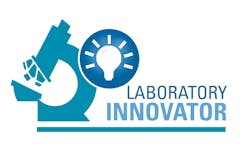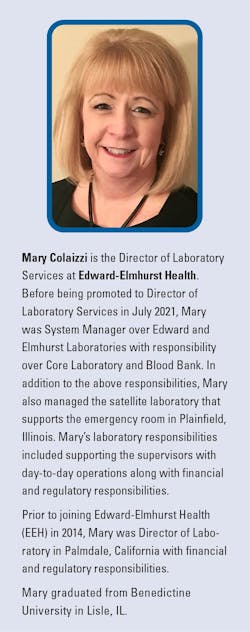Could you describe the customer service attributes of your laboratories that you are most proud of?
I am most proud of our customer service staff. They are experienced and extremely knowledgeable about the laboratory. Our customer service center is located at our Elmhurst laboratory and the team fields calls for both Edward and Elmhurst laboratories. The team will investigate issues prior to handing off concerns to the departments. A recent example was forwarded to our leadership: “kudos” from our LabCorp employee stated the Chiquila is extremely knowledgeable and will take the time to read all notes and will use all the tools provided before reaching out, in addition, she is very polite and always has a positive attitude.
Are there particular lessons learned you can share with other laboratory directors on reducing laboratory errors?
In March of 2020 our laboratory created a Quality Coordinator position as a system role between Edward and Elmhurst. We were honored to hire Michelle Irving into this role who held various positions that supported the laboratory over the past 12 years. Michelle has a passion for quality and has enhanced our quality program.
Each month we discuss our quality metrics at each hospital and then compare Edward to Elmhurst to each other. This is a nice way to understand challenges that each hospital may be facing and discuss opportunities to improve processes. Some lessons that we have learned over the years is that we need to have all instruments interfaced to reduce manual entry and human error. In addition, we have a very supportive laboratory IT team — most of this team are MLS’s that understand workflow within the laboratories.
What is the current vacancy rate at your lab? What strategies have you found to be successful in recruiting and retaining staff?
Currently, our vacancy rate is 5.8% with 12 FTE openings across both Edward and Elmhurst laboratories. During the pandemic, we experienced a vacancy rate as high as 24%. Last November as we were experiencing staff burnout, we needed to hire agency staff to fill the void. Over the past 10–11 months, as new staff have come on board, we were able to end the contracts with our agency staff. We are very thankful that we were able to find agency staff to lessen the burden on our employees.
In the past 6–8 months, we worked very hard on strengthening the on-boarding process in the lab. As new employees finish the hospital orientation, we have their second day on the job as a lab orientation in a group setting. For example, if we have five new hires in a week across both Edward and Elmhurst, we gather all the new employees at one location to go through the mandatory safety and new hires mandatory modules together. The supervisors will rotate the education and take the team to lunch. This is a nice way to connect with the new employees. In addition, it’s a nice way to connect leadership to all department staff to get to know each other better. Our leaders are expected to check-in with the new staff members on a weekly basis and document how their training is proceeding and what they need in order to make the transition more seamless. In addition, we ask “what can we do better?”
Some strategies that we have implemented over the past two years are quarterly “Round Table” discussions with a few staff members from each department. This forum is about 4–5 staff members, we talk openly with their supervisor, manager, and director to discuss what is going well, what obstacles or processes are needing some attention, etc. We start the conversation with “This is a safe place, and we are here to listen, nothing is off limits.”
Do you have strategies you can share for getting new tests and equipment approved for your laboratories?
Edward and Elmhurst merged with Northshore in January 2022; over the past (almost) two years we have engaged in conversations to learn from each other. Then, in May of 2023, the whole laboratory system is now under one VP of all the laboratories to better align across the whole NS-EHH system. With the new laboratory organizational structure, we have opportunities to better align standardization across the system and obtain better vendor contracts. Most recently, all eight acute care hospitals have standardized Diagnostica Stago Coagulation instrumentation and soon will all align with Grifols automation in our blood banks.
We are beginning to look at redundancies across the system especially with some of our lower-volume tests. We immediately found approximately 20 send-out tests that we can send to a sister hospital to save over $100K per year by keeping the testing within our system.
What challenges do you experience in directing laboratories in a multi-hospital system?
I think the biggest challenge is trying to split my time between both campuses so that I can engage with staff on a regular basis. It’s exciting to begin the journey with a larger hospital system to learn from each other and share our experiences with standardization and look for opportunities to look for cost savings as all costs are continuing to rise with goods and services.


